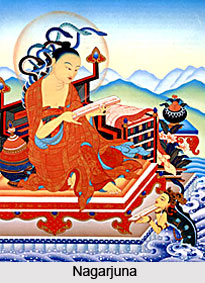 Nagarjuna (150 CE) was presumably born in Andhra Pradesh in South India into a Brahmin family. He later converted to Buddhism. Nagarjuna is one of the most famous Buddhist philosophers and was even considered as the greatest Buddhist philosopher after Lord Buddha himself. He is also referred to as the "Second Buddha" and also as a part of the "Six Scholarly Ornaments". This group also includes Aryadeva, Asanga, Vasubandhu, Dignaga and Dharmakirti.
Nagarjuna (150 CE) was presumably born in Andhra Pradesh in South India into a Brahmin family. He later converted to Buddhism. Nagarjuna is one of the most famous Buddhist philosophers and was even considered as the greatest Buddhist philosopher after Lord Buddha himself. He is also referred to as the "Second Buddha" and also as a part of the "Six Scholarly Ornaments". This group also includes Aryadeva, Asanga, Vasubandhu, Dignaga and Dharmakirti.
According to Buddhist tradition, Nagarjuna was the founder of the Madhyamika School. Madhyamika School is one of the important schools where Buddhist monks and disciples are preached and taught about Mahayana Buddhism.
Contributions of Nagarjuna
Nagarjuna is primarily remembered for his contribution to the Buddhist philosophy. His writings formed the foundation of the Madhyamika School. The "Prajnaparamita Sutras" were also developed by him. Nagarjuna was closely associated with the University of Nalanda. Nagarjuna"s most important works are the "Mulamadhyamaka Karikas" and "Vigrahavyavartani". He developed further the concept of emptiness or "Sunyata". This doctrine is also related to the concepts of "Anatta" and dependent origination. He is also believed to develop the two-truth doctrine. According to this philosophy there are two levels of truth. One is the ultimate truth and the other is the conventional truth or the "Upaya". In "Kaccayanagotta Sutta", Nagarjuna describes the doctrine in details.
Teachings of Nagarjuna
The teachings of Nagarjuna are still widely followed in Mahayana Buddhism. Nagarjuna insists that the Abhidharma outlook is contrary to authentic Buddhist teaching which says everything is empty of inherent nature. According to him, entities with essential nature would have to be self-created, which is not possible. Nagarjuna also insists that whatever is interdependently originated it is devoid of essential nature. If there are no essences, there are no stable entities with clearly defined identities. He denies that causation is a real relation. Events happen sequentially and human minds impose associations that are treated as causal realities. There are no types, kinds or classes of entities.
In Buddhism, he is also seen as someone who has both the qualities of a human and the snake. In Indian tradition, the snake is responsible for rain and other water bodies. In Buddhism this term refers to wise person or even an elephant.
Death of Nagarjuna
Nagarjuna"s death is also associated with several legends. While some say that he spent his last days meditating at Shri Parvatha Mountain, others are of the opinion that Nagarjuna was killed by his opponent.




















